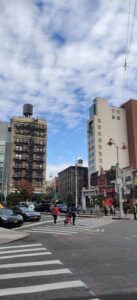When discussing gentrification in New York City, Chinatown is often forgotten. At a glance, it is difficult to make the assumption that the area is gentrifying due to the immense amount of culture that was brought in by immigrants. Even after the area saw major improvements in gang warfare and unsanitary living conditions in the 1980s, the area was able to retain its cultural identity and maintain its affordability. However, after the events of September 11, Chinatown residents began to feel anxious on how this would affect them. Due to the neighborhood’s close proximity to the Financial District, it was inevitable that the area would be used to help aid the recovery of New York City. Thus in 2008, Mayor Michael Bloomberg zoned Chinatown, and many other low income communities, with a pro-development plan. Chinatown was upzoned to allow for more development to occur in the area to help increase the flow of money to New York City. This benefited corporations, developers, and the local government. However, when creating a plan to help New York City, actual tenants living in these neighborhoods were left out of the picture. Therefore, this left an opening for gentrification in the area. One of the most famous early examples of gentrification in Chinatown was when a community supermarket, Pathmark, was removed to make space for a luxury building, the One Manhattan Square. This luxury building provided a sharp contrast to the neighborhood with its architectural design and height and signified that zoning was going to change the residential landscape of the area.
Hence, the area continued to see an increase in developments such as more luxury condominiums, trendy restaurants, expensive stores, boutique hotels and more. As the amount of developments increased, the property value of the neighborhood also began to increase. This led to increased rent prices in apartments and previously rent stabilized apartments through landlord harassment. Meanwhile, designated affordable housing in the area began to be unaffordable because using the area median income as a guideline, these apartments still ended up too expensive for Chinatown residents. These factors for residential gentrification are caused by the little protection offered in the original zoning plan of Chinatown. Tenant organizations have responded to this by protesting and proposing a rezoning of the area to protect their community residents.
In this field research study, the issue of Lower Manhattan’s residential gentrification was explored. The scope of research covered was Community District 3 which includes Chinatown, Lower East Side, and the East Village. The main question that drove this research was if tenants in similarly gentrified areas mostly feel negative or positive impacts from gentrification. Other questions such as how tenant organizations and landlords have responded to the gentrification of these areas. With preliminary online research, it is predicted that most tenants would express a net negative attitude towards gentrification. To determine whether this hypothesis is plausible within the scope of this study, field research was conducted. The objective of this research is to examine how a pro-development zoning plan affected housing for residents. The following study consists of interviews with tenant associations, landlords, surveys for the general public, and observations in the field.




